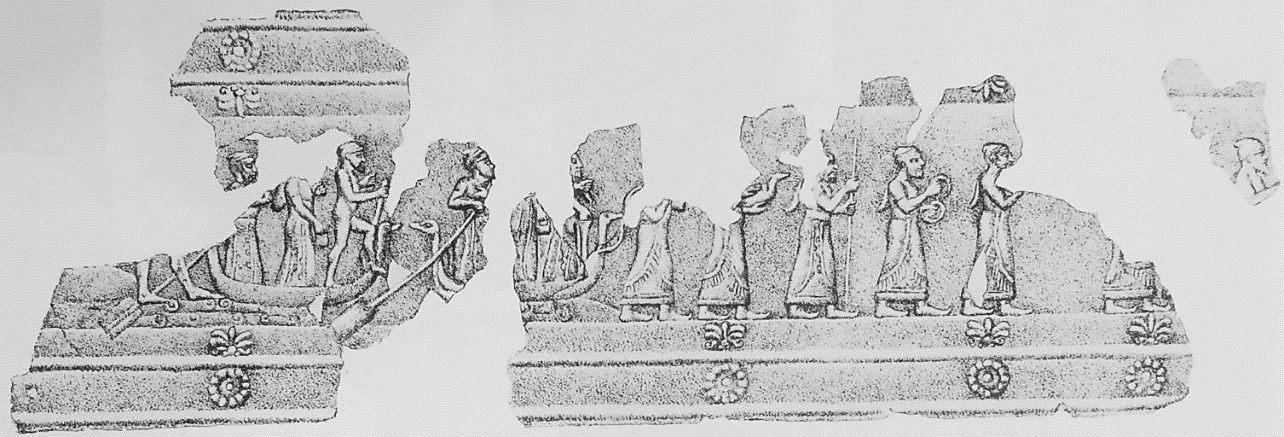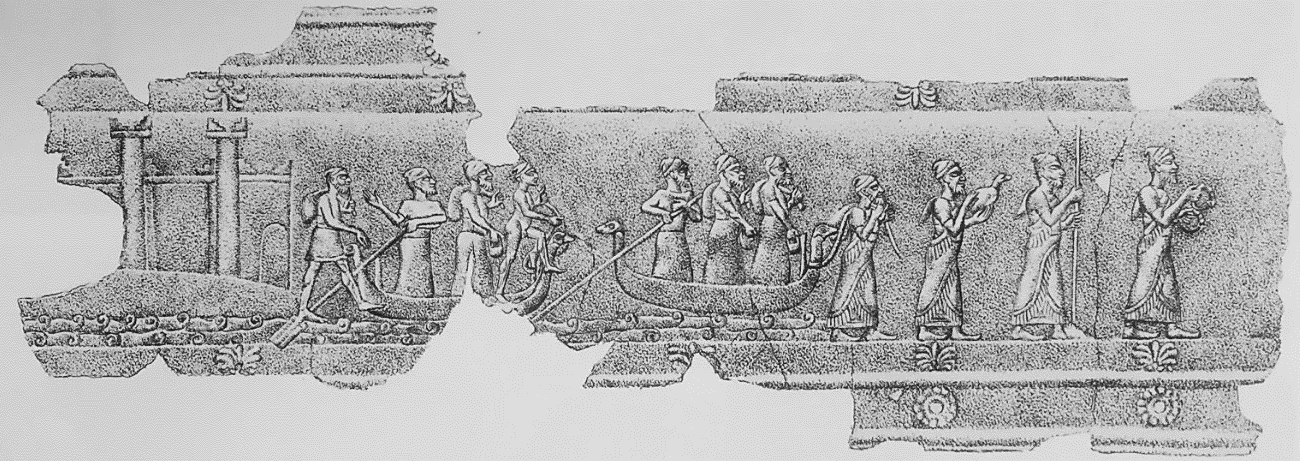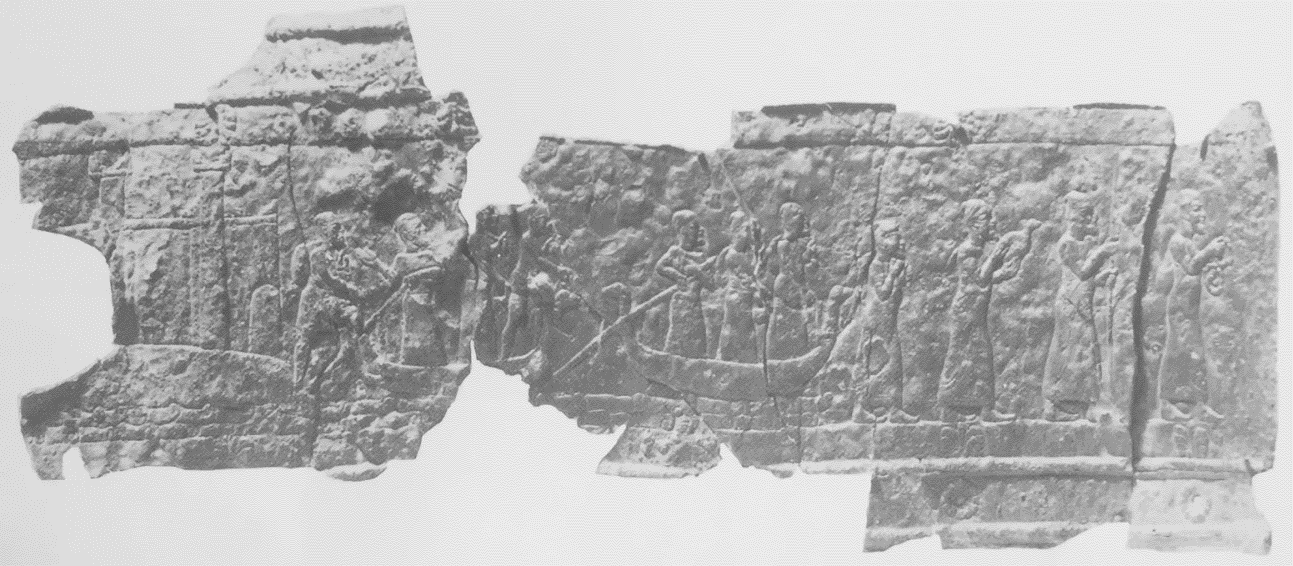Perfectly symmetrical boats with a flat hull and high vertical posts ending in a naturalistic duck head device. The boats are altogether very similar to those of the Shalmaneser III bands except for the duck head devices instead of those of a horse, and the rectangular shaped oar blades with a central rib. The angle of the posts from one boat to another on these bands shows much less deviation, and they are all clearly perfectly vertical. Some of the boats show the steering oar supported by a stanchion. The other difference (not related to the execution of the boats themselves) is that all the boats with the exception of one show three individuals aboard instead of two. In bands L5 and R4, a fourth figure is shown in the process of stepping into the boat with one leg outstretched. On band L4, that individual is simply standing next to the boat in the water with both feet on the ground.
Ferrying of Phoenician tribute
L26
Reign of Ashurnasirpal II (883-859 B.C.)
Temple of Mamu, Balawat, Northern Iraq
L4: H: 18 cm; L: 39 cm (frg.); L5: H: 20.5 cm; L: 52.3 cm (frg.); R4: H: 19.8 cm; L: 49.8 cm (frg.)
Three fragmentary bands of bronze sheet with embossed and chased decoration
MM ASH II L4; MM ASH II L5; MM ASH II R4
Curtis 2009: 431-34, figs. 4-6; Curtis and Tallis 2008: 57-58, 65, figs. 64, 66, 80; Degrado 2019: 118-119, fig. 7; Grayson 1991: A.O.101.1: iii 84-88 (annals)
These bands belong to a third set of gates at Balawat which were set up in a temple dedicated to the god Mamu, located between the courtyard (room 3) and the antecella (room 2). These are similar in size to the ones of Ashurnasirpal II, ie smaller than the Shalmaneser gates but likewise consisting of double doors with eight bronze bands on each door leaf. The bands show campaigns on the Euphrates river, in Urartu, and probably in Phoenicia. There are three bands identified as relating to Phoenicia: L4, L5 and R4. Unlike the Shalmaneser bands, these are actually located in the middle of the gates. Curtis thinks that this is not accidental, and that the Assyrians therefore must have seen this campaign(s) as particularly important. None of the bands are inscribed. Their identification as representing tribute from Phoenician cities is inferred from the maritime character of the compositions, the presence of an island, the appearance of the tributaries, and the nature of the tribute.
Ashurnasirpal reached the Mediterranean Sea only once during his reign, in a western campaign dated c.875-867 B.C. His annals read: "At that time I made my way to the slopes of Mount Lebanon (and) went up to the Great Sea of the land Amurru. I cleansed my weapons in the Great Sea (and) made sacrifices to the gods. I received tribute from the kings of the sea coast, from the lands of the people of Tyre, Sidon, Byblos, Mahallatu, Maizu, Kaizu, Amurru, and the city of Arvad, which is (on an island) in the sea - silver, gold, tin, bronze, a bronze casserole, linen garments with multi-coloured trim, a large female monkey, a small female monkey, ebony, boxwood, ivory of nahirus (which are) sea creatures." Based on this text and the different rendering of the island as a smooth slope with a fortress extending to the water's edge, Curtis has plausibly argued that the island in this case is Arwad, not Tyre.
Band L4: Tribute is being brought to the mainland from an island using two boats with duck head devices. The right boat is being pulled to the shore with a rope. The island itself is missing but the smooth profile of the shore line is still visible. The tributaries have beards and soft caps with bending tops. For those wearing footgear, the shoes or boots have upturned toes. The figures are dressed in various ways. Some have long dresses decorated with circles, over which they wear long belted robes with a split reaching up to the waist. Others are alternatively dressed with long dresses worn under fringed overgarments with one end thrown over the shoulder. The tribute depicted includes animal skins, buckets, a bird, a staff, and rings or bracelets.
Band L5: A very similar composition to the previous band except that the fortified city on the island is partly preserved on the left side of the band. It rests on a smooth mound and extends right to the water's edge. At the front of the fortress on the seaward side is a doorway with a rounded arch at the top. Behind the front section are two towers and part of a third. Stepped crenellations are observable on the tops of the turrets amd at intervals at the top of the walls. The tributaries wear either long belted robes or the long dresses with fringed overgarments with the ends thrown over the shoulder. They wear the same type of shoes or boots with upturned toes and are bearded. The tribute is identical to that of Band L4.
Band R4: Very similar composition of tribute brought from an island fortress in two boats of the same type with duck head devices. The fortress is on the right and is altogether very similar to that of Band L5 except for the crenellations on the tops of the walls are missing. This is possibly due to the two figures standing on top of the battlements. The tributaries are bearded and have the same type of boots. They wear long dresses decorated with circles beneath long robes with a split reaching up to the waist. The tribute presented is slightly different: cauldrons, animal skins, buckets, and a dish.
Degrado notes that the tributaries depicted on the Mamu gates are shown in less submissive postures, contrasting their straight backs during the procession with those of the forward-leaning individuals pulling the boats ashore (Degrado 2019: 118).
Curtis, J. 2009. “Phoenicians on the Balawat Gates,” BAAL Hors-Série 6: 427-438.
Curtis, J. and N. Tallis (eds). 2008. The Balawat Gates of Ashurnasirpal II. London: British Museum Press.
Degrado, J. 2019. “King of the four Quarters: Diversity as a rhetorical Strategy of the Neo-Assyrian Empire.” Iraq 81: 107-125.
Grayson, A. K. 1991. Assyrian Rulers of the early First Millenium BC I (1114-859 BC). The Royal Inscriptions of Mesopotamia, Assyrian Periods. Toronto: University of Toronto Press.











